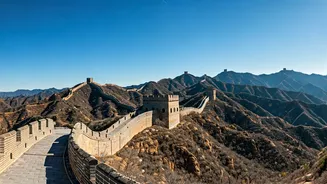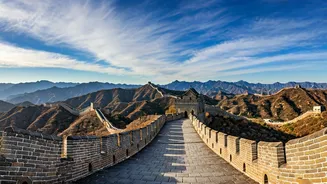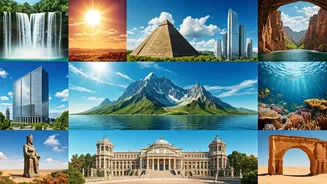The Great Pyramid
The Great Pyramid of Giza, an enduring symbol of ancient Egypt, stands as a testament to the remarkable engineering skills of its builders. Constructed
over four thousand years ago, this colossal structure served as a tomb for the pharaoh Khufu. The pyramid's precise alignment with cardinal directions and its intricate internal passages highlight the advanced knowledge of mathematics and astronomy possessed by the ancient Egyptians. The sheer scale of the project, involving the transportation and placement of massive stone blocks, continues to astound modern-day engineers. The Great Pyramid’s presence, viewed as a monument to power, religious belief, and the pursuit of immortality, underscores its significance. This structure invites reflection on the past's ingenuity and the mysteries still hidden within its ancient walls. Its timeless appeal continues to draw visitors from across the globe.
The Colosseum's Glory
The Colosseum, a historic amphitheater in Rome, Italy, bears witness to the glory of the Roman Empire. Constructed nearly two thousand years ago, this iconic structure hosted gladiatorial contests, public spectacles, and dramatic events. Its innovative design, featuring a complex system of arches, vaults, and corridors, allowed it to accommodate tens of thousands of spectators. The Colosseum's interior, once a vibrant arena, now stands as a symbol of the empire's power, social dynamics, and entertainment culture. Even in ruins, the Colosseum still inspires a sense of awe. The historical importance of this building highlights the ingenuity and societal values of the Roman people, making it a must-see landmark for visitors.
Machu Picchu Unveiled
Perched high in the Andes Mountains of Peru, Machu Picchu is an ancient Inca city. Built in the 15th century, this remarkable site offers a glimpse into Inca civilization. Its location, surrounded by towering peaks and deep valleys, showcases the Incas' ability to adapt to difficult terrains. Machu Picchu's sophisticated stonework, terraced agriculture, and intricate architectural designs provide insight into the ingenuity of the Inca people. The city was abandoned, remaining hidden from the world for centuries until its rediscovery in 1911. Its rediscovery ignited interest in Inca history. The preservation of this location gives visitors the ability to understand ancient cultures and civilizations, making it an extraordinary travel destination.
The Taj Mahal's Beauty
The Taj Mahal, a mausoleum in Agra, India, is a timeless symbol of love and architectural brilliance. Commissioned by Mughal emperor Shah Jahan in memory of his wife Mumtaz Mahal, its construction was completed in 1648. Crafted from white marble, the Taj Mahal stands out for its balanced symmetry, elaborate details, and stunning craftsmanship. The integration of Persian, Islamic, and Indian architectural styles symbolizes cultural harmony. Visitors from all over the world gather to observe the Taj Mahal's beauty. The exquisite details and serene surroundings make it a place to reflect on art and history. The Taj Mahal remains a tribute to enduring love and creativity.
The Great Wall
The Great Wall of China, a massive fortification, winds through the landscapes of China. Built over centuries, its purpose was to protect the Chinese Empire from invaders. The wall's construction involved the efforts of millions, spanning from the Qin dynasty onward. Its length, reaching over 13,000 miles, demonstrates the scale of the defensive project. This construction includes sections of walls, watchtowers, and fortifications. The Great Wall showcases the architectural skills and organizational prowess of ancient China. The iconic Great Wall is an enduring testament to human determination and a powerful symbol of Chinese history.
Chichén Itzá's Secrets
Chichén Itzá, an ancient Mayan city on the Yucatán Peninsula in Mexico, offers insights into Mayan civilization. The central structure, El Castillo, is a stepped pyramid showcasing Mayan astronomical knowledge. The city's layout, aligned with astronomical events, reflects the Mayans' understanding of the cosmos. The intricate carvings and detailed architecture demonstrate the Mayans' artistic achievements and complex society. The site was abandoned centuries ago. However, Chichén Itzá continues to fascinate visitors. The exploration of this place gives travelers the chance to understand Mayan culture, history, and architectural prowess.
Christ the Redeemer
Christ the Redeemer, a colossal statue in Rio de Janeiro, Brazil, stands as an iconic symbol of faith and cultural significance. Completed in 1931, the statue towers over the city from atop Corcovado Mountain. Its outstretched arms provide an inviting embrace, representing openness and peace. The monument provides exceptional views of Rio's stunning landscapes. The statue has become a globally recognized emblem, bringing together visitors from across the world. The statue is a representation of hope and devotion, making it a prominent landmark in the world.
Petra's Carvings
Petra, an archaeological site in Jordan, is a city carved into sandstone cliffs. Established by the Nabataean civilization around the 4th century BC, Petra was a central hub for trade. The city's stunning facades, including the Treasury and the Monastery, show the Nabataeans' skill. The intricate carvings, water management systems, and strategic location highlight their abilities. Petra was lost to the world for many centuries until its rediscovery in 1812. Today, it stands as a UNESCO World Heritage site and draws countless tourists. Petra is a representation of the ingenuity, resilience, and artistic brilliance of ancient civilizations.
The Roman Forum
The Roman Forum, once the center of ancient Roman life, provides an exceptional glimpse into the political, social, and religious heart of the Roman Empire. Located in the heart of Rome, this area was filled with temples, government buildings, and public spaces, serving as the stage for important events. Walking through the ruins, one can imagine the debates, ceremonies, and daily activities that once took place. The remains of structures like the Temple of Saturn and the Arch of Titus reflect Roman power, cultural achievements, and organizational capabilities. The Forum's historical importance makes it a great spot for understanding Roman culture and legacy.













